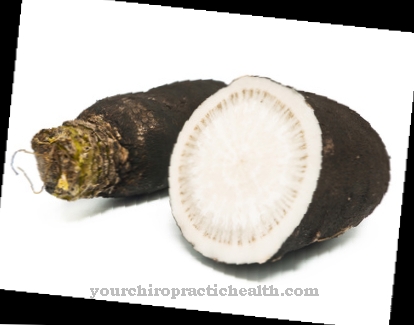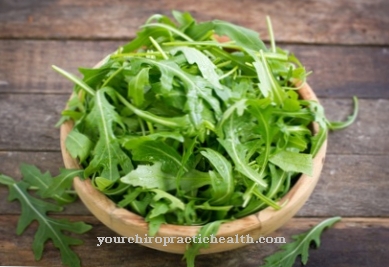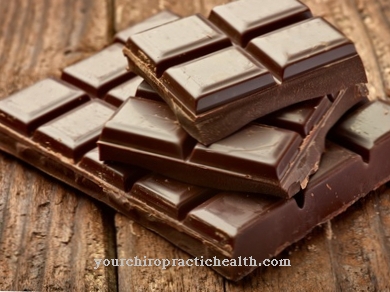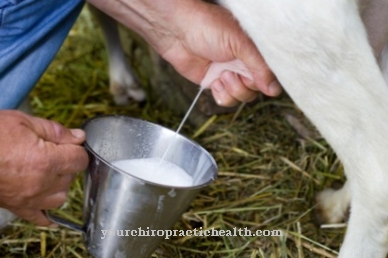The pulp of the Watermelon is a wonderful refreshment on hot summer days. The melon, which weighs up to 20 kilograms, contains many valuable nutrients with few calories and is easy to get in the summer months.
What you should know about watermelon

The watermelon originated in southern Africa, but is now grown in numerous warm regions around the world. The first watermelon was grown around 5000 years ago.
In addition to cultivated watermelons, there are also wild forms of the fruit. Like the cucumber, which is related over a few corners, it belongs to the cucurbit family. Around 150 varieties of watermelon are known. Watermelons grow - due to their high weight alone - close to or even directly on the ground on a herbaceous, creeping, heavily branched plant with angular, hairy stems and widely spreading roots. Each of these plants can reach up to 10 meters in length. It takes around two months from growing a plant to harvesting the first watermelons. The flowers of the watermelon plant are yellow and less large than many other cucurbits.
Watermelons are available in a few shops all year round, but their main season is summer, when they are a very refreshing and thirst-quenching snack. Particularly large specimens can weigh up to 20 kilograms, some varieties even a little more. Their diameter is usually around 20cm, the length can even reach up to 60cm.
The watermelon is easy on the eyes: the flesh is usually bright red and contains small, white and slightly larger, dark brown seeds. In addition to watermelons with red flesh, there are also special varieties with orange, yellow, white or even green flesh. Breeding has made it possible to largely reduce the number of pips in some watermelon varieties. Since the pulp tastes pleasantly sweet and fruity, the watermelon is a very popular snack even with children.
The peel of the watermelon is green and can be up to four centimeters thick. Their color spectrum ranges from light green with dark green speckles or stripes to a rich dark green that envelops the whole melon.
Importance to health
The watermelon is a low-calorie and alkaline food. In addition to many vitamins and minerals, it also contains antioxidants that strengthen the immune system.
Since the melon has a very high water content of around 95 percent and only a little sodium, it helps the body to drain the kidneys and to cleanse them of harmful substances. In addition, their consumption helps to bring the entire water balance of the body back into balance. The watermelon also contains the amino acid "citrulline", which is converted into arginine by the body. It is also an amino acid that has a dilating effect on the blood vessels and thus helps to lower blood pressure and thus reduce the risk of serious cardiovascular diseases.
The watermelon is also rich in vitamins. The content of vitamin A, vitamin B6 and vitamin C is particularly high. The contained vitamin A promotes eye health, vitamin B6 strengthens the nerves and vitamin C helps the immune system to keep the body healthy.
Ingredients & nutritional values
| Nutritional information | Amount per 100 gram |
| Calories 30 | Fat content 0.2 g |
| cholesterol 0 mg | sodium 1 mg |
| potassium 112 mg | carbohydrates 8 g |
| protein 0.6 g | vitamin C 8.1 mg |
The watermelon consists of at least 90% water, it contains about 0.03 mg vitamin A, 0.04 mg vitamin B1, 0.05 mg vitamin B2, 0.07 mg vitamin B6, 0.07 mg vitamin E, 11 mg calcium, 0.4 mg iron , 109mg potassium, 9mg magnesium and 0.1mg zinc.
Intolerances & allergies
Pumpkins, which also include melons, are potentially allergenic. However, a watermelon allergy is very rare and manifests itself in rather harmless symptoms such as stomach cramps, nausea or diarrhea. It should also be remembered that watermelon contains fructose. People with a fructose intolerance should only consume them in moderation.
Shopping & kitchen tips
In the summer months a watermelon is available in every supermarket and discount store at relatively low prices. From the outside, a watermelon with its firm skin can hardly be seen how ripe the inside is.
This is where the so-called "knock test" helps: The melon is held near the ear with one hand. One knuckle of the other hand is used to tap the melon lightly. If the melon sounds hollow and emits a light tone, which can best be described as "metallic", it is not yet ripe and therefore not suitable for immediate consumption as it still has to ripen. If, on the other hand, the tone is dull but still sonorous, the perfect degree of ripeness has been reached and the melon can be consumed immediately.
A fresh, whole watermelon can be stored very well at room temperature. It stays fresh for a few days to several weeks. A watermelon that has already been cut can be covered with cling film at the interfaces and then placed in the refrigerator. So it stays fresh for a few days: it can be stored for about seven days without too many of its valuable vitamins dwindling. If you already know that a whole melon is too much for you before you buy it, you can buy watermelons cut in half at the fruit dealer.
Preparation tips
In summer, watermelons are usually eaten raw and chilled. It is also very good in cocktails, bowls and smoothies, as a sorbet or in ice cream.
In order to cut the rather unwieldy watermelon, the two ends should first be cut off. A large, sharp knife should be used for this. A saw knife is perfect for cutting melons. Once the ends of the watermelon have been removed, it can be set up and divided in the middle.The halves can now easily be cut into columns and these can be processed into handy triangles or cubes if necessary. For this purpose, the pulp is cut perpendicular to the skin and then cut out with a cut directly along the skin.













.jpg)

.jpg)
.jpg)











.jpg)